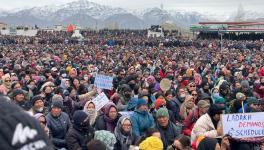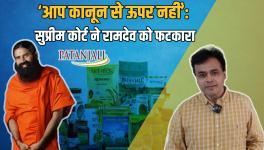How to Beat those who Deleted Kashmiri Newspaper Archives

A month after Aakash Hassan tweeted his story, Kashmir’s Vanishing Newspaper Archives, on 23rd November, it continues to be widely shared on social media. Hassan’s story, in a nutshell, is about journalists unable to locate on the internet the pieces they had written for Kashmiri newspapers before 5 August 2019, the date on which Article 370 was read down and Jammu and Kashmir’s autonomy squashed.
The story portrayed an unseen but omnipotent hand selectively deleting URLs from the digital archives of media outlets. Many of these URLs were of stories on human rights abuses in Kashmir. Among those affected was Hilal Mir, who became the editor of the Kashmir Reader in 2016—and lasted a little over a year in that post. Mir found all his stories had been wiped out from the Reader’s digital archive.
Clues there were a plenty in Hassan’s story as to who could have ordered the scrubbing out of digital archives. For instance, journalists working for the Greater Kashmir said articles began disappearing from the archive after the newspaper’s owner and editor-in-chief, Fayaz Kaloo, was questioned, in July 2019, by the authorities about certain stories published in 2016, the year in which Kashmir erupted over the killing of the militant poster-boy, Burhan Wani.
The link between the questioning of Kaloo and articles disappearing from his newspaper’s archive could well have been coincidental. Yet it also posits a hypothesis, even though subliminally, that URLs are unlikely to go missing without the consent or order of owners and editors wishing to obviate trouble from the state. Or out of their compulsion to please the government for getting its advertisements, a veritable lifeline for regional newspapers lacking in resources.
The story of Kashmir Times
But this possibility fails to explain the strange occurrence at the Kashmir Times, which the wife-husband team of Anuradha Bhasin and Prabodh Jamwal oversee. They are among India’s feisty journalists. After Article 370 was read down and the internet was inaccessible for months, Bhasin judicially challenged the communication shutdown in Kashmir. “Messages from bureaucrats would come that did I have to go to court,” said Bhasin, executive editor, Kashmir Times. She did not relent.
This is why most people find it inconceivable that Bhasin and Jamwal would scrub out their newspaper’s archive at the behest of the powerful. “Our digital archive from 2011 to 2016 has disappeared,” lamented Jamwal, who is the newspaper’s editor. Asked to guess who the culprit was, Jamwal said, “Either hackers or a member of our tech team.”
Thereby hangs a tale.
Access to the innards of any website is controlled by a key or password, often generated by a software, which two staff members, generally, possess. It is possible, Jamwal argues, for an entity, be it angry state officials or jealous competitors, to buy out or scare the possessor of the password into tampering with the website.
Hassan’s story on vanishing archives had Sajad Haider, editor of the Kashmir Observer, ascribe the missing data from his newspaper’s website to hackers, who broke into the system several times in the past. Hackers often do so for a lark, and boast of their skills by uploading weird messages or links to pornographic sites.
But state and non-state actors are also known to hire hackers. Call them sponsored hackers. They have a defined purpose. In the case of Kashmir Times, their goal was the deletion of data from its digital archives. Just as experienced thieves wipe out fingerprints before ferreting away their loot, so do sponsored hackers erase all evidence of having slipped into the system. As long as the website’s technical team does not plug the lacuna, sponsored hackers continue with their surreptitious visits, stealing or deleting data, as has happened with the Kashmir Times.
This is precisely why Jamwal and Bhasin cannot state when precisely the stories featured between 2011 and 2016 went missing from their newspaper’s digital archive. Their discovery was accidental, dating to October.
It so happened that Kashmir Times, as is typical for all media outlets, received notices from advocates whose clients had been exonerated of the criminal charges levelled against them. These clients were named as accused in the newspaper’s reports based on police briefings. The advocates wanted the previous reports to be either taken down or altered to include the fact of exoneration, as web stories, unlike their print version, are always accessible and can, therefore, permanently damage reputations. Around the same time, Kashmir Times received queries from writers who had written stories for the newspaper in the past but internet searches for them yielded no result.
In both instances, Jamwal searched for the URLs furnished to him. Blank. Suspicious, Jamwal matched cataclysmic events between 2011 and 2016 and whether stories done on them were featured in the Kashmir Times. Once again, a blank. It was impossible that the Kashmir Times would have not features stories on those bloody events.
The Kashmir Times website is hosted by a server owned by a California-based company. But the newspaper does not have an arrangement with the company for taking backups. Nor does it park its data on the cloud, which is essentially a system of interconnected servers at a remote place. The Kashmir Times team takes backups and stores them on two computers, one at its Jammu office and the other at its Srinagar branch. But the Srinagar office has been out of bounds for Jamwal and Bhasin after it was sealed on 19 October, 2019.
Jamwal said, “We have the data dump on the machine in Jammu. But it is not segregated by date, for we could not upload material on our website on a daily because of prolonged internet shutdowns.” He can be faulted for not opting for the cloud storing facility or asking the California-based company to take backups on its server. “Everything costs money,” Jamwal said. “We can be hacked so easily because we, unlike national media outlets, cannot afford a robust protection system.”
As such, government ads have been denied to Kashmir Times since 2008. It has had to countenance multiples notices from the Income Tax department, Labour Department, Provident Fund Organisation and Employees State Insurance Corporation. Each of these notices involve court appearances—and expenses. Bhasin said, “Prabodh spends so much time in court that I tease him that he is now an advocate, not a journalist.”
Given that the Kashmir Times has hard copies of all its daily editions, since 1991, stored in its brick-and-mortar archive, it might seem to make no sense for anyone to scrub out a segment of its digital archive. But the advantage of digital archives is that it can be accessed from any part of the world. It searches faster and more precisely than humans can.
Digital archives are particularly handy for rights groups, particularly those based abroad, evident from their reports that contain a plethora of URLs to media stories. Anyone who has pored over bound copies of newspapers in libraries are aware of the time and energy required to search for news items. Even a civil rights group based, say, in Delhi will incur expenses to travel and stay in Kashmir for collecting evidentiary material. The selective scrubbing out of digital archives, indeed, raises obstacles before those who want to challenge the state’s narrative.
Wonder called Wayback Machine
I mined the Wayback Machine to see whether I could retrieve data for Kashmir Times. I was able to pull out seven URLs to its pages from 2016. I passed these URLs to Jamwal. He, too, took to the Wayback Machine and retrieved over 50 URLs to the Kashmir Times website, dating to the 2011-2016 period. I was also able to recover Hilal Mir’s four stories from 2016. He can read them here, here, here and here.
Created in 1996 and made available to the public in 2001, the Wayback Machine releases a crawler, which is a software programme that traverses the worldwide web. The crawler visits websites, famous or little known, capturing data. The capturing of data at a point of time on a particular date is called snapshot, which enables users to access URLs copied and stored on the Wayback Machine.
When you insert the URL of a website in the search field of the Wayback Machine, you are taken to the calendar of certain years. Each calendar has coloured dots on certain dates. Press those having blue dots—and you can see the website as it was on that date. All stories of that date have new URLs, which are different from the links generated by the website where these were originally published. The URLs generated by the Wayback Machine can be accessed, read and preserved. For instance, I accessed Hilal Mir’s stories, missing from the digital archive of the Kashmir Reader website, only because it was on the Wayback Machine with new URLs.
Quite a system to save your work from delete-happy, compromised editors and owners. In fact, every individual can archive his or her stories on the Wayback Machine.
But there is a catch.
A website, holding the copyright to all material published by it, can ask for the exclusion of its URLs from the Wayback Machine’s archive. Does this not defeat the very purpose of the Wayback Machine, which, when you log into it, greets you with the message: “They’re trying to change history—don’t let them. The Wayback Machine is a crucial resource in the fight against disinformation… Right now, we’re preserving history as it unfolds…”
I emailed the above question to Mark Graham, Director, the Wayback Machine at the Internet Archive, a digital library providing free access to all. Graham replied, “We live in a complex world of nuances, balance and, at times, conflicting values, law and practice. [While] we work very hard to archive as much as we can, to preserve it and make it available, we also recognise the Wayback Machine is a collection of other people’s work. They own that work, we don’t.”
Mark Graham’s offer
But remember, since the government does not hold the copyright to material published by media outlets, it cannot make exclusion requests to the Wayback Machine. This means not only entities such as the Kashmir Times can save every edition of its newspaper on the Wayback Machine—and insulate it from sponsored hackers—even editors keen to please the powers that be can play the double game. Before deleting URLs from their digital archive, they can upload them on the Wayback Machine to slyly save information for posterity.
Graham wrote to me, “I would love to help them [news websites]. No fee required.” The Wayback Machine merely asks for donations from users. Graham even offered, “Please give me a list of news websites and I will ensure we archive them every day.” Remember, the Wayback Machine’s crawler does not visit every news website daily.
The Wayback Machine is a veritable bonanza for freelance or independent journalists, who, in India, hold the copyright to their articles unless they have waived it in favour of media outlets which published them. In other words, a website cannot legally approach the Wayback Machine to exclude URLs of journalists holding rights to their work.
Apar Gupta, advocate and Executive Director, Internet Freedom Foundation, said to me that freelancers can have a clause inserted in their contracts with media outlets that they assert their “moral right” to their own work. “Or they can have a line saying that the website cannot ask a third party—for instance, the Wayback Machine—to remove URLs to their pieces kept for archival purposes,” Gupta said to me.
But this issue has yet to be tackled by the Wayback Machine because, as Graham said, it “may have never processed an exclusion request from a news site in India.” In these early days of disappearing newspaper archives, it is vital for journalists to assert their rights and save their work from permanent erasure.
Importance of memory
It is also vital because what is at stake is the nation’s memory, which has a pivotal role in the ideological battles of the present. It is also about knowing and accepting the truth. As Bhasin said, “The story of missing archives tells us that they are not only uncomfortable about the present but also about the past. Archives of newspapers are our memory of the past. They want to efface the memory.”
The effacing of Kashmir’s memory would mean blanking out the causes of the interminable ferment there, the names of those who fomented it, and the suffering inflicted on its people; it will erase the register of human rights abuses and examples of the security establishment’s overreach, which has inflicted wounds not only on Kashmiris, Muslims and Hindus alike, but also on soldiers deployed there. It will deprive us the yardstick for comparing the present situation to that of the past. It could, in the future, even be claimed that neither India nor Kashmir ever bled.
It will, above all, allow political players, particularly the Bharatiya Janata Party, to engage in myth making. Bhasin warns, “Kashmir is the BJP’s experimental laboratory, and although the scene in other parts of India is just 10 percent of what happens in Kashmir, it is reason enough for all to worry.” Bhasin’s warning rings true against the backdrop of the Modi government tightening its control over the media.
Kashmir could well become an instructive lesson in effacing or manipulating regional memories. Our little histories, so to speak, will be deleted. In its place will arise a singular history, an incomplete history. The goal of recovering multiple memories has authors of books on the past spend lonely hours in brick-and-mortar archives, poring over regional publications, which may lack in style and elan, but never in substance. To erase the archives of regional newspapers is to erase the essential Indian personality, blessed with contradictory, even conflicting, traits, each struggling to flower.
Novelist Milan Kundra wrote, “The struggle for power is the struggle of memory against forgetting.” As omnipotent fingers stealthily steal into archives and hunt for URLs to delete, the Wayback Machine or its alternatives can be our weapon in memory’s fight against forgetting.
The author is an independent journalist. The views are personal.
Get the latest reports & analysis with people's perspective on Protests, movements & deep analytical videos, discussions of the current affairs in your Telegram app. Subscribe to NewsClick's Telegram channel & get Real-Time updates on stories, as they get published on our website.
























